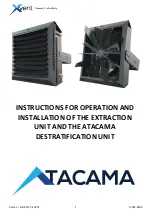
34
Canadian Air Handler Installation and Operation
•
Follow piping manufacturer
’
s
requirements for any additional required
flushing or cleaning of coil and piping if
using non
-
copper piping.
•
Do not engage pump until the flushing
process is completed. Running pump dry
will cause damage.
CAUTION
Flushing the hot water coil prior to start up is
required to remove any residual material from the
installation or manufacturing processes as well
as remove any air from the system.
Use an external purge valve or other mechanism
to flush hot water coil after installation. Take
precautions while flushing the air handler to keep
the multi
-
function control board and other
electrical components from getting wet. Hot water
is preferred for flushing.
Follow the flushing steps listed below. Use a
bucket or hose to dispose of water from the bleed
valve during flushing.
1.
Flush the return line by closing the inlet valve
(supply) and opening the purge valve
(return). Open the purge valve. Close the
bleed valve when flushing is complete.
2.
Flush the supply line and coil by closing the
outlet valve (return) and opening the inlet
valve (supply). Open the purge valve. Close
the purge valve when flushing complete.
3.
Apply power to the air handler. Open inlet
and outlet valves. Engage pump and open
purge valve. Verify proper flow direction—
inlet should become warm before outlet.
Close the purge valve when flushing is
complete.
4.
Operate pump for five minutes immediately
after flushing system to purge remaining air
from the pump bearing chamber.
The following conditions must be met prior to starting
the air handler. Refer to outdoor condensing unit
installation instructions for system start
-
up instructions
and refrigerant charging instructions.
Is unit properly located, secure, and
serviceable?
Is the unit protected from vehicular or other
physical damage?
Is the return air not obtained from areas where
there may be objectionable odors, flammable
vapors or products of combustion such as
carbon monoxide (CO), which may cause
serious personal injury or death?
Has an auxiliary pan been provided under the
unit with separate drain for units installed above
a finished ceiling or in any installation where
condensate overflows could cause damage?
Auxiliary drain is installed when necessary and
pitched to allow for draining?
Has the drain pan and drain tubing been leak
checked?
Have all webs been removed from the drain
connections that are being used? Have all drain
pan plugs not used been properly plugged?
Ensure all air in the hot water loop is removed
to ensure optimal efficiency and to prevent
premature pump failure.
Is the ductwork correctly sized, run, taped, and
insulated?
Have all cabinet openings and wiring been
sealed?
Verify all coils, valves, and piping are leak free
and insulated if required.
With main power disconnected, verify that the
blower wheel is well fixed on the motor shaft
and the wheel turns freely.
Is the filter clean, in place, properly oriented,
and of adequate size?
Are all electrical connections properly sized and
tightened?
Is the wiring neat, correct, and in accordance
with the wiring diagram and rating plate?
Is the unit properly grounded and protected
(fused)?
Is the thermostat correctly wired and in a good
location?
Are all access panels in place and secure? A
safety switch prevents the startup of the blower
if the front panel is not installed.
Check Blower Operation:
Set the thermostat
to
“
FAN ON.
”
Does the indoor blower turn on?
Continued on next page
Summary of Contents for CAH Series
Page 1: ...C US ...
Page 2: ...2 Canadian Air Handler Installation and Operation Manual ...
Page 39: ...Canadian Air Handler Installation and Operation Manual 39 ...
Page 44: ......
































